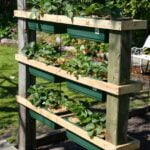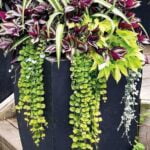Landscape timber ideas have the potential to transform your outdoor space in unique and creative ways. From raised garden beds to pathways, edging, and outdoor furniture, landscape timber offers endless possibilities for DIY projects. In this article, we will explore the versatility of landscape timber and how it can be used to enhance the aesthetic appeal and functionality of your garden or yard.
One of the most popular uses for landscape timber is in creating raised garden beds for DIY gardening projects. We will discuss how landscape timber can be used to build sturdy and long-lasting garden beds, adding a charming touch to your outdoor space while also providing a practical solution for growing plants and vegetables.
In addition to raised garden beds, we will also explore how landscape timber can be used to create pathways and walkways that are both durable and visually appealing. Whether you’re looking to add a charming pathway through your garden or create a sturdy walkway from one area of your yard to another, landscape timber provides a versatile solution that is sure to impress.
Raised Garden Beds
Landscape timber is a versatile and practical material that can be used in various outdoor projects, including creating raised garden beds. These DIY gardening projects are not only functional but also add a charming and rustic look to your outdoor space. Raised garden beds offer several benefits, such as better soil drainage, reduced weed growth, and easier access for planting and maintenance.
When using landscape timber for raised garden beds, it’s important to choose high-quality timber that is resistant to rot and decay. Typically, pressure-treated timbers are the best option for longevity and durability. Additionally, proper installation is crucial to ensure the stability of the raised garden beds over time. Use rebar or galvanized spikes to secure the timbers at each corner and stagger the joints for added strength.
Another advantage of using landscape timber for raised garden beds is the flexibility it offers in terms of customization. You can create various shapes and sizes to fit your gardening needs, whether you prefer a simple rectangular design or more intricate layouts. With the right tools and techniques, landscape timber can be easily cut and assembled into personalized raised garden beds that complement your outdoor landscape.
In addition to its functional benefits, landscape timber provides an attractive natural aesthetic to raised garden beds. The warm earthy tones of the timber blend seamlessly with nature, making it an appealing choice for those looking to enhance their gardens. Whether you’re a beginner or experienced gardener, incorporating landscape timber into your DIY gardening projects can elevate the visual appeal of your outdoor space while offering practical advantages.
| Benefits | Considerations |
|---|---|
| Better soil drainage | Choose high-quality, rot-resistant timber |
| Reduced weed growth | Proper installation with rebar or galvanized spikes |
| Easier access for planting & maintenance | Flexibility for customization |
Pathways and Walkways
Creating a charming and durable pathway with landscape timber can add a unique and rustic touch to your outdoor space. Whether you’re looking to create a meandering garden path or a straight walkway, landscape timber is a versatile and affordable option for DIY projects. One of the best features of using landscape timber for pathways is its durability, making it suitable for high-traffic areas in your yard.
When designing your pathway, consider using different sizes and shapes of landscape timber to add visual interest. You can opt for natural wood tones or use paint or stains to customize the look of the timber to complement your outdoor decor. Additionally, landscaping fabric can be used as a base layer underneath the timber to prevent weed growth and help maintain the pathway’s structure over time.
For added safety, consider adding solar-powered lights along the pathway to illuminate the area at night. This not only enhances the visual appeal of the pathway but also provides visibility and guidance for walking after dark. Whether you’re creating a pathway through your garden or leading up to your front door, landscape timber is a versatile material that allows for endless design possibilities.
| Material | Size | Price (Per Linear Foot) |
|---|---|---|
| Landscape Timber | 4″ x 4″ | $1.50 |
| Landscape Timber | 6″ x 6″ | $2.75 |
Edging and Borders
Landscape timber is a versatile and popular material for adding a rustic and charming touch to your outdoor space. One of the creative ways to use landscape timber is by incorporating it into edging and borders for your garden. Not only does this add an aesthetic appeal to your garden, but it also helps define and separate different areas of your outdoor space.
Here are some amazing ideas for using landscape timber for edging and borders in your garden:
- Define flower beds: Create a clean and defined border around your flower beds using landscape timber. This not only helps keep the soil and mulch in place but also adds an elegant touch to your garden.
- Pathway borders: Use landscape timber to edge the sides of pathways or walkways in your garden. This not only creates a visually appealing pathway but also provides a durable border that helps maintain the shape of the pathway over time.
- Vegetable garden borders: If you have a vegetable garden, consider using landscape timber to create raised beds with built-in borders. This not only adds character to your garden but also makes it easier to maintain and harvest your crops.
Incorporating landscape timber into edging and borders in your garden is a great way to enhance the overall look of your outdoor space while adding functionality at the same time. Whether you’re looking to define specific areas, prevent soil erosion, or simply add an elegant touch, landscape timber is a perfect choice for achieving these goals. So get creative with your landscape timber ideas and start transforming your outdoor space today.
Outdoor Furniture
There are countless possibilities when it comes to using landscape timber for DIY outdoor furniture projects. Whether you are looking to create a cozy bench, a sturdy table, or even unique decorative pieces, landscape timber provides a durable and rustic charm that is perfect for outdoor settings. Here are a few ideas to inspire you:
- Adirondack chairs: Landscape timber can be used to construct timeless Adirondack chairs, perfect for lounging in your garden or on your patio.
- Picnic tables: Build a sturdy and long-lasting picnic table using landscape timber, ideal for enjoying outdoor meals with family and friends.
- Garden benches: Create charming garden benches with landscape timber for a cozy seating option in your backyard oasis.
In addition to traditional furniture pieces, consider taking your outdoor space to the next level with unique and functional creations such as:
- Outdoor bar: Utilize landscape timber to build an outdoor bar complete with shelves for storage and serving space for entertaining.
- Planter benches: Combine the functionality of seating and gardening by constructing planter benches using landscape timber, perfect for adding greenery to your outdoor space while providing seating options.
- Swing sets: Create custom swing sets using landscape timber for a charming and nostalgic touch to your outdoor area.
The natural texture and durability of landscape timber make it an ideal material for creating long-lasting and attractive outdoor furniture. From simple benches to more complex projects like intricate tables or decorative accents, the versatility of landscape timber allows you to bring your creative visions to life while enhancing the ambiance of your outdoor space. So put on your DIY cap and start building.
Retaining Walls
Utilizing landscape timber for retaining walls is a great way to add both functionality and visual appeal to your outdoor space. Whether you are looking to create terraced gardens or prevent soil erosion, landscape timber can be an excellent choice for building durable and attractive retaining walls.
Benefits of Landscape Timber Retaining Walls
One of the key advantages of using landscape timber for retaining walls is its natural rustic look. The textured appearance of the timber adds a charming and timeless quality to the overall landscape design. Additionally, landscape timber is a cost-effective and readily available material, making it an accessible option for DIY projects. It is also relatively easy to work with, allowing for flexibility in design and construction.
Design and Construction
When designing and constructing a retaining wall with landscape timber, it is important to consider the dimensions, drainage, and reinforcement required for your specific project. Proper planning and execution are crucial in ensuring the structural integrity and longevity of the retaining wall. Additionally, incorporating features such as steps or seating areas can enhance the functionality and aesthetic appeal of the overall design.
Maintenance and Longevity
To ensure the longevity of your landscape timber retaining walls, proper maintenance is essential. Regular inspections for damage, rot, or structural issues should be conducted, and any necessary repairs should be promptly addressed. Applying a sealant or protective finish can also help extend the lifespan of the timber by protecting it from moisture, UV rays, and other environmental factors that may cause deterioration over time.
Overall, utilizing landscape timber for retaining walls provides a versatile solution for enhancing both the form and function of your outdoor space. By carefully planning the design, construction, and maintenance of these structures, you can create beautiful and enduring retaining walls that complement your landscaping while serving practical purposes.
Planters and Flower Boxes
Benefits of Using Landscape Timber for Planters and Flower Boxes
Landscape timber is an excellent choice for creating planters and flower boxes due to its durability, versatility, and natural aesthetic. The use of landscape timber can add a charming rustic touch to your garden while providing an ideal environment for growing various plants and flowers. Its sturdy construction ensures that your planters will withstand the elements and remain an attractive addition to your outdoor space for years to come.
Design Ideas for Landscape Timber Planters
When it comes to designing planters and flower boxes with landscape timber, the possibilities are endless. You can create traditional rectangular planters, tiered flower boxes, or even unique geometric designs to suit your gardening needs and personal style. Additionally, landscape timber can be easily cut and assembled to accommodate different sizes and shapes, allowing you to customize your planters to fit specific areas of your garden or patio.
Maintenance Tips for Landscape Timber Planters
To ensure the longevity of your landscape timber planters, it’s important to follow proper maintenance practices. Applying a protective sealant or stain can help prevent water damage or rotting caused by exposure to moisture. Additionally, regular inspection of the planters for any signs of wear or damage is essential for addressing issues before they escalate. By taking these measures, you can enjoy beautiful and functional landscape timber planters that enhance the overall appeal of your outdoor space.
Maintenance Tips
Landscape timber structures are a wonderful addition to any outdoor space, but it’s important to properly care for and maintain them in order to ensure their longevity and continued functionality. One of the key factors in maintaining landscape timber structures is regular inspection. Check for any signs of damage such as rot, warping, or insect infestation. Catching these issues early can prevent further damage and expensive repairs down the line.
In addition to regular inspections, it’s essential to protect landscape timber structures from the elements. Apply a weatherproof sealant or stain to help prevent water damage, decay, and UV ray exposure. This will not only extend the lifespan of your landscape timber structures but also enhance their appearance.
Proper drainage is also crucial for maintaining landscape timber structures. Make sure that any raised garden beds or retaining walls have adequate drainage systems in place to prevent water buildup and potential structural damage. Additionally, be mindful of moisture levels in the soil around landscape timber planters and flower boxes, as excessive moisture can lead to wood rot.
By following these maintenance tips, you can ensure that your landscape timber structures remain beautiful and functional for years to come. With proper care and attention, you can continue to enjoy the charm and durability of your landscape timber creations for many seasons ahead.
Conclusion
In conclusion, landscape timber offers a wide range of possibilities for enhancing and adding functionality to your outdoor space. From raised garden beds to pathways and walkways, edging and borders to outdoor furniture, retaining walls to planters and flower boxes, the versatility of landscape timber is truly remarkable. The rustic charm and durability of landscape timber make it a popular choice for DIY gardening projects and outdoor design.
Whether you are looking to create a charming garden pathway or build unique rustic furniture pieces, landscape timber provides an ideal material for bringing your outdoor design ideas to life. Its natural appeal adds character to any space while its functionality makes it a practical choice for various landscaping projects. With proper maintenance, landscape timber structures can stand the test of time and continue to enhance the beauty of your outdoor area for years to come.
So, whether you are a seasoned gardener or a DIY enthusiast, consider incorporating landscape timber into your outdoor space. With the right ideas and creativity, you can transform your garden into a beautiful and functional oasis using this versatile material. Embrace the beauty and functionality of landscape timber in your outdoor space, and enjoy the benefits of its durability and natural appeal.
Frequently Asked Questions
What Is the Best Timber for Landscaping?
The best timber for landscaping depends on the specific project and its requirements. Treated wood, such as pressure-treated pine, is a popular option due to its durability and resistance to rot and insects. Redwood and cedar are also good choices because of their natural resistance to decay.
What Do You Put Under Landscape Timbers?
When using landscape timbers, it’s recommended to place a layer of landscaping fabric or plastic sheeting underneath them. This helps prevent weeds from growing through the timbers and provides some protection against moisture and soil erosion.
What Can You Make Out of Landscape Timbers?
Landscape timbers can be used to create a variety of outdoor structures and features. These include retaining walls, raised garden beds, edging for flower beds or pathways, steps, benches, and even simple playground equipment like sandboxes or playhouses. Their versatility makes them an attractive material for DIY landscaping projects.

Welcome to my gardening blog! I am passionate about plants and enjoy sharing my knowledge and experiences with others. In this blog, I will write about everything related to gardening, from tips on how to get started to updates on my own garden projects.





